

What Is Biofeedback Therapy?
Biofeedback therapy is the process of learning to change your physiological activity for the purpose of increasing self-regulation and decreasing mental and physical symptoms. Your heart rate, breath rate, finger temperature, skin conductance, and muscle tension are recorded and analyzed in real-time by a computer-based program. Through sounds or visual graphs, you learn to change your physiological activity and alleviate symptoms.
How Biofeedback Therapy Helps


Biofeedback therapy can help you alleviate unwanted symptoms, decrease the severity of medical conditions, and achieve peak performance. Through biofeedback training, you’ll learn to control your breathing, muscle tension, body temperature, and skin conductance. You learn to increase your heart rate variability, a measure of psychological and physical health. As a result, you’ll gain relief from troublesome symptoms like panic attacks, depression, headaches, and abdominal pain and learn to function optimally. Repeated training can get you to a place where you no longer need instruments to reinforce healthy responses and behaviors.
CONDITIONS TREATED
-
TRAUMA & PTSD
-
CHRONIC PAIN
-
DEPRESSION
-
ANXIETY AND ANXIETY DISORDERS
-
SUBSTANCE USE DISORDERS
-
PERFORMANCE ENHANCEMENT
-
TRAUMATIC BRAIN INJURY (TBI)
ASTHMA
-
MIGRAINE HEADACHE
-
TENSION-TYPE HEADACHE
HYPERTENSION
-
IRRITABLE BOWEL SYNDROME
-
TEMPOROMANDIBULAR JOINT DISORDER (TMJD)
-
ARTHRITIS
-
CONSTIPATION
-
FIBROMYALGIA
IMMUNE FUNCTION
INSOMNIA
RAYNAUD’S DISEASE
-
STROKE
TINNITUS
-
ATTENTION-DEFICIT HYPERACTIVITY DISORDER (ADHD)
DISORDERED EATING AND BODY IMAGE, INCLUDING ANOREXIA, BULIMIA, BINGE EATING
Schedule a Free Consultation
Contact us to schedule a free, 15-minute phone consultation to learn more and see if our integrative psychology services are right for you.
